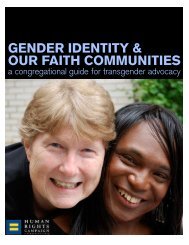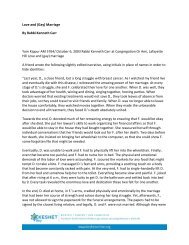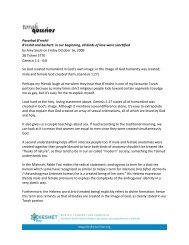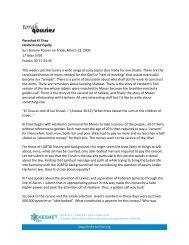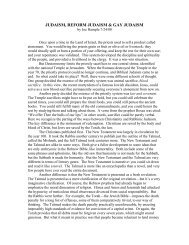Parashat Terumah The Gift of Safe Space by Y. Gavriel A ... - Keshet
Parashat Terumah The Gift of Safe Space by Y. Gavriel A ... - Keshet
Parashat Terumah The Gift of Safe Space by Y. Gavriel A ... - Keshet
You also want an ePaper? Increase the reach of your titles
YUMPU automatically turns print PDFs into web optimized ePapers that Google loves.
<strong>Parashat</strong> <strong>Terumah</strong><strong>The</strong> <strong>Gift</strong> <strong>of</strong> <strong>Safe</strong> <strong>Space</strong><strong>by</strong> Y. <strong>Gavriel</strong> A. Levi Ansara on Saturday February 24, 20076 Adar 5767Exodus 25:1 - 27:19<strong>Parashat</strong> <strong>Terumah</strong> opens with G-d speaking to Moses on Mount Sinai and commanding him inmeticulous detail regarding the construction <strong>of</strong> the Mishkan, or “tabernacle,” the portabledwelling place <strong>of</strong> G-d’s presence that the Israelites could promptly assemble, dismantle,transport, and then reassemble during their sojourn in the desert. G-d tells Moses: “Daber elBnai Yisrael veyikchu li terumah me’et kol ish asher yidvenu libo tikchu et terumati./ Speak tothe Children <strong>of</strong> Israel and have them bring Me an <strong>of</strong>fering. Take My <strong>of</strong>fering from everyonewhose heart impels him to give” (Exodus 25:2). Hashem continues <strong>by</strong> commanding Moses toacquire fifteen materials for the construction <strong>of</strong> the Mishkan—each item a gift or <strong>of</strong>fering(terumah), and each to be brought <strong>by</strong> someone “whose heart impels him.” <strong>The</strong> <strong>of</strong>feringsinclude gold, silver, and copper; blue, purple, and red-dyed wool; flax, goat hair, and animalskins; acacia wood, olive oil, spices and gems. This lengthy description <strong>of</strong> the <strong>of</strong>feringsnecessary for the Mishkan emphasizes the multiplicity and diversity <strong>of</strong> color and material, asymbolic acknowledgment that sacred community cannot exist without embracing the uniqueexperiences and identities <strong>of</strong> all Jews.<strong>The</strong> glaring contrast between the luxurious aesthetics describing the Mishkan and the pr<strong>of</strong>ounddisplacement <strong>of</strong> our people is intentional. It is at precisely this juncture in our history that ourpeople achieved what many Jewish sages characterize as the height <strong>of</strong> human achievement.<strong>The</strong> Mishkan becomes the standard from which melachah, (constructive activities prohibited onShabbat and holidays) and there<strong>by</strong> major halachot (Jewish laws) concerning Shabbat, arederived.Why does the construction <strong>of</strong> the Mishkan occur during this period <strong>of</strong> strife and disaffection?What motivating force drives the desire to give <strong>of</strong>fering to Hashem at the height <strong>of</strong> exile? It isthe same drive that propels gay, lesbian, bisexual, trans, genderqueer and intersex (GLB/TGI)Jewish refugees from oppressive communal environments to renew the empty realms <strong>of</strong> theirhearts <strong>by</strong> turning to Hashem, transforming derelict emotional landscapes into the Binyan AdeiAd (everlasting home) that their souls crave.
their sense <strong>of</strong> isolation. Yet it is not Hashem who has spurned them; it is not Hashem who hascruelly propelled them from the sheltering warmth <strong>of</strong> their social networks. <strong>The</strong> harmfulactions <strong>of</strong> other people are not direct statements <strong>of</strong> Divine Will, regardless <strong>of</strong> assertions to thateffect <strong>by</strong> those who inflict emotional and spiritual damage upon others in the guise <strong>of</strong>religiosity. In <strong>Parashat</strong> <strong>Terumah</strong>, G-d <strong>of</strong>fers these embittered outcasts the gift <strong>of</strong> a safe space,filled with luxurious beauty and sustenance, to nourish them as they journey in search <strong>of</strong> placeswhere their values as GLB/TGI people are not pitted against their devotion to Jewishobservance.This crossing is arduous enough that we cannot afford to take any opportunities for spiritualenrichment for granted. <strong>Parashat</strong> <strong>Terumah</strong> provides us with an empowered model for survivalprecisely because both our traditional observance and our GLB/TGI experiences are integral toour existence. It may be a Friday night Shabbat gathering in a small living room containing ahandful <strong>of</strong> similarly devoted friends, or the quiet peace <strong>of</strong> lighting candles alone in your kitchenwith your same gender bashert. It may be laying tefillin at home in the morning as a trans manwho finds himself unable to pass in a small community where everyone knows his history, orlighting candles to welcome the Shabbat Queen as a trans woman carrying on the legacy <strong>of</strong> herforemothers. <strong>The</strong>se simple acts <strong>of</strong> affirmation define us in the same way that the Mishkandefined our spiritual ancestors in the desert. To my fellow travelers in this struggle for spiritualaffirmation, I urge you to turn toward Hashem, to allow yourselves to receive the awaitingbounty <strong>of</strong> your own private Mishkan. Shabbat Shalom u’Menuchah.




